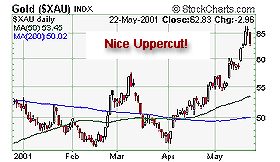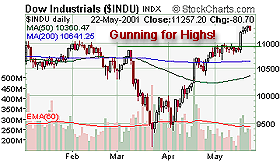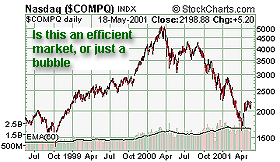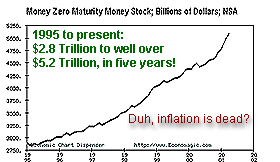|
Inflation
Breakout |
||||||||
Just as I was thinking about a fitting title for this week's report, last Wednesday, I began to wonder: Greenspan just finished lowering the State interest rate, five times, to nearly half of what it was only five months ago. Something spectacular has got to go off here. $50 oil, I thought! Sure enough, the charts look good. Anything is possible now. Something will give, where people least expect. I began to wonder what questions the markets might debate this week, when I received what I think is a timely email from one of our readers:
The second I read it I knew the answer. Of course, you know the answer too because we've been discussing it since the summer. In fact, the only reason that no one else knows it is because there is only one piece left to prove what everyone already sees happening around him or her. The very validation by the gold market itself, for what we all prefer to deflation anyhow: perpetually rising prices - the last bastion of profitability, under the current monetary order. The enormous monetary inflations we've had over the decade past have already been blowing holes in the price structure of the economy, giving price taking industries the decisive edge in attracting investment interest, a trend likely to continue. It is only utter irony that anyone sees these price distortions as deflationary. But first, in order to understand how far gold prices might ultimately go, we need to understand what a free gold price is generally anticipated to prevent: The Inflation
Breakout! Note the consequence of the collision between delusion and reality, in the Nasdaq chart below. Now consider the historical reality that inflation will result in monetary confiscation as well as economic dislocation… against the delusion that a growing productive economy needs ever more liquidity if it is to grow.
It often seems as though humans can only make essential paradigm shifts when a crisis confronts them. Until that day, however, they are usually content with the delusion of the day. It will not make a difference to the outcome, whether you anticipate it, or not. The conflict between reality and delusion is inevitable. But it does, however, make a difference to you. National
Delusions: to delude or not… that is the question Psychologists classify delusion as: an unshakable belief in something untrue. These irrational beliefs defy normal reasoning, and remain firm even when overwhelming proof is presented to dispute them. When an individual has deluded himself to the point that it affects his or her ability to cope with life, he or she will probably see a psychologist, who will provide all sorts of treatment. I am no psychologist, so it is only my observation that the capacity for self-delusion is not just apparent in every walk of human life, and especially in market life, but that we have also learnt how effective a tool it can be for managing so many daily tasks. It is a choice, on some level, often between perpetuating a self-delusion and dealing with an unpleasant truth. Other times the desire to have something impossible to acquire is a good motivator. To a whopping extent, the remarkable technology bubble was a national, and perhaps, global delusion based on a vision of the very distant future. Of course, many people haven't accepted that yet, which is why the bear market ain't over. If it is still too much to imagine that the modern world can, over and over, continue to fall for such schemes, consider that human history is absolutely littered with one bizarre example of national delusion, after another. We've studied accounts of many of them, and have found very few examples of individuals that were able to avoid participating in them. (See Charles MacKay's Extraordinary Popular Delusions and the Madness of Crowds) The Bubble Masters (like Smith's invisible hand: you can't see them but if they don't exist, they might as well) know that, if nothing else, humans have throughout history shown that under certain economic conditions, they will pay dearly for the promise of safety, wealth, or admiration. We on the other hand often forget that the bubble heads exist in the first place because we want them to. Maybe it helps to forget about what we are really paying with - liberty. Why is it that the job of a man that makes potions at the traveling show, is as secure as that of a Doctor?
All through history, it is always the same: a group of very powerful people discovers the secret to human fallibility: the individual predilection for self-delusion. It is in this new world monetary order, one without an anchor, which the investor must at all costs work hard to arm himself with an ability to recognize unpleasant truth, if he is to win The Battle For Investment Survival (the title of Gerald Loeb's bestseller is coincidental). This Week in the GIC:
Sincerely, |
||||||||




